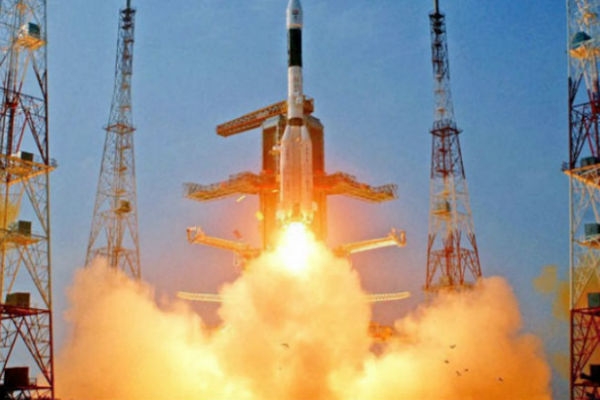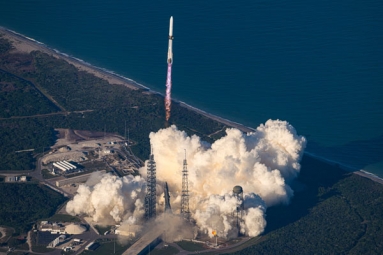
On Monday, Indian Space Research Organisation (ISRO) has successfully launched its most powerful rocket, GSLV Mk III, which is nicknamed as ‘Fatboy,’ by firing the high thrust indigenous cryogenic engine in the first developmental flight and thus placed the country’s heaviest satellite in the orbit.
With this launch, ISRO has demonstrated its expertise in developing the cryogenic engine, the technology which was denied to ISRO years ago. This launch proved the homegrown launch vehicle's capability of hurling up to four tonne payload into the higher orbits.
This successful launch has also laid a strong foundation for the ISRO’s ambitious future projects, which include Chandraayan-II and also a manned mission, alongside of venturing with the global heavy payload market.
GSLV Mk III-D1 carrying the communication satellite GSAT-19 has been lifted off from the second launch pad at the Satish Dhawan Space Centre in Sriharikota at 5.28pm. Around 16 minutes after the takeoff, the rocket has successfully placed the satellite in the geosynchronous transfer orbit.
President of India, Pranab Mukherjee has tweeted on 5th June, 2017, The nation is proud of this significant achievement.
The nation is proud of this significant achievement #PresidentMukherjee
— President of India (@RashtrapatiBhvn) June 5, 2017
Congratulating the scientists and also others who have worked for the successful mission, the Isro chairman A S Kiran Kumar said that: "It is a historic day. The entire team has worked since 2002. The vehicle carried the next generation satellite. We are looking forward to getting the satellite operational."
Dr K Sivan, director of Vikram Sarabhai Space Centre said that, "It is the commencement of two complex technologies - a vehicle that can carry twice the payload weight and a high throughput satellite. It is the continued efforts of the team and industry contribution."
The three-stage vehicle has been propelled by CE-20, an indigenously designed and developed cryogenic engine, in its upper stage (C25 stage) before the vehicle ejected the satellite into the orbit. Later, the GSAT-19's propulsion system will be used for the satellite to reach the geostationary orbital home.
This launch is also first flight for the CE-20 engine, which was under the developments since 2002. The CE-20 engine, which runs on the less complex technology compared to its Russian design predecessors, has undergone more than 200 tests during the last few years.
P Kunhikrishnan, the director of Satish Dhawan Space Centre said, "Isro has made it a habit to execute complex jobs in the most professional way. This has culminated in yet another successful event in Sriharikota."
Kunhikrishnan also said that integration for the next launch PSLV C38 is going to take place in the first launch pad simultaneously. "It is planned in the next half of the month. The next GSLV Mk III will be integrated in the new vehicle assembly coming up which will be three times bigger," Kunhikrishnan said.
The GSLV – MKIII D1/GSAT-19 mission takes India closer to the next generation launch vehicle and satellite capability. The nation is proud!
— Narendra Modi (@narendramodi) June 5, 2017
Prime Minister of India, Narendra Modi tweeted on 5th June, 2017 that, The GSLV - MKIII D1/GSAT-19 mission takes India closer to the next generation launch vehicle and satellite capability. The nation is proud!
GSAT-19 carried the transponders and also a geostationary radiation spectrometer. The instrument which will monitor and study the nature of charged particles and also the influence of space radiation on the satellites and about their electronic components.
In the month of December 2014, a miniature version of GSLV Mk III has carried a 3,775kg experimental crew module. But the mini version vehicle did not have the cryogenic engine as it was just a demonstration of the design.
ISRO took five years to taste the first success with GSLV Mk II after the engine has failed 800 milliseconds into ignition in its first flight on 15th April, 2010. The vehicle has been carrying GSAT-4 satellite.
First successful flight of the indigenously made cryogenic stage powered GSLV Mk II was on 5th January, 2014 when the vehicle carried GSAT-14. Since that period, Mark II has seen four successful flights, which include the launch of South Asia Satellite on 5th May, 2017.
PSLV C38 launch:- ISRO chairman Kiran Kumar said that, PSLV C38 would be launched on 23rd June, 2017.
NASA Plans To Launch Spacecraft To Touch The Sun
Mrudula Duddempudi.







